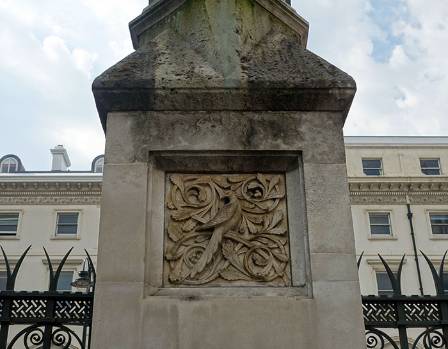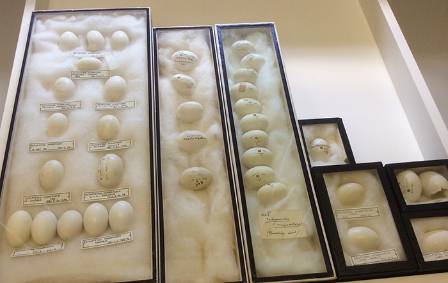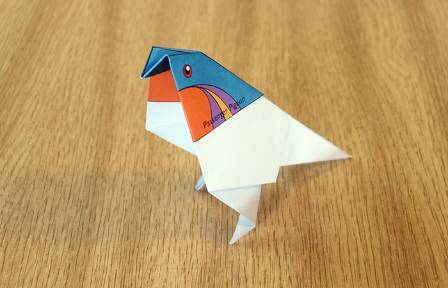Today is the 100th anniversary of the death of the last living passenger pigeon. After the dodo, it is one of the most famous examples of human-caused extinction in the world.
To commemorate, I (with some invaluable help and contributions from my Museum colleagues, the Smithsonian Institution, @GrrlScientist and Joel Greenberg's book A Feathered River Across the Sky: The Passenger Pigeon's Flight to Extinction) have compiled a list of 100 passenger pigeon-related facts.
- The scientific name for the passenger pigeon is Ectopistes migratorius.
- It was officially described by Carl Linnaeus in 1766 as Columba migratoria.
- It was later re-classified as Ectopistes migratorius because of its longer wings and tail, and larger overall size, than the dove family Columbidae.
- Ectopistes means 'moving about or wandering' and migratorius means 'migrating'.
- The first recorded mention of the passenger pigeon was by ship captain Jacques Cartier in July 1534.
- Journeying along the shore of Prince Edward Island, Cartier noted in his journal: 'an infinite number of wood pigeons'. He mistook the birds he saw for the wild pigeons he was familiar with in Europe but it was later agreed that what he had seen were passenger pigeons.
- The first published depiction of the species is believed to be by Mark Catesby, in The Natural History of Carolina, Florida, and the Bahama Islands volume 1, in 1754, although he called the bird Palumbus migratorius, the pigeon of passage.

Mark Catesby's 1754 illustration of a passenger pigeon.
Picture courtesy of the Biodiversity Heritage Library.
- The passenger pigeon is sometimes called a 'wild pigeon' or 'blue pigeon'.
- Its colour is actually a blue-grey, with shades of red-orange and brown also prominent, as well as iridescent markings at the neck. Colours in the male are brighter and more bold than in the female.
- The average length of a male passenger pigeon was about 16.5 inches. The female around an inch shorter.
- Our Museum holds nearly 80 passenger pigeon specimens in its collection, comprised:
- 35 skins,
- 3 mounted specimens (two in London, one in Tring),
- 2 skeletons (one partial, one complete),
- And nearly 40 eggs.
- You can see the mounted specimens on display in the Birds gallery in London and Gallery 1 at Tring.

Two passenger pigeons on display in the Birds gallery in London: a male (left), and female (right).
- While not strictly a specimen, we do have another passenger pigeon - this one is a terracotta sculpture designed by Alfred Waterhouse. You can see it on the Museum side of the pillars in our fence along Cromwell Road.
- The terracotta depictions of creatures where placed according to status: extant (i.e. living forms) on the west side; extinct on the east side.
- Today there are two notable exceptions to this rule: the passenger pigeon which was alive when the building was erected in the late 1800s, but is now extinct; and the coelacanth, which was thought to have gone extinct 85 million years ago, but was rediscovered in 1938.

Waterhouse's terracotta passenger pigeon on one of the Cromwell Road pillars. Now on the wrong - extant - west side of the Museum.
- The passenger pigeon was native to North America.
- It was a wild bird, not to be confused with the carrier pigeon, a domesticated bird trained to carry messages.
- Passenger pigeons were migratory birds.
- In winter they would roost in the southern states, from the Gulf Coast to Arkansas and North Carolina.
- In spring, they would fly north to nest in the region of the Great Lakes and east to New York.
- The passenger pigeon population is estimated to have been somewhere between 3 and 5 billion in the early and mid-1800s.
- However, Mark Avery, former conservation director of the RSPB, puts the figure between 5 and 10 billion.
- It is thought that the species once constituted 25-40% of the total bird population of the United States.
- Alexander Wilson, a great bird observer of the time, estimated a flock he saw contained 2,230,272,000 individuals.
- To put that in perspective, the RSPB estimates the UK population of pigeons (wild rock doves [550K] and wood pigeons [5.4m] combined) is about 6 million breeding pairs.
- Imagine more than 400 times the entire UK population of pigeons flying together in one group - that's what passenger pigeon flocks were like!
- Passenger pigeon flocks were so large they would block out the sun and they would take several days to pass over towns.
- Flocks were regularly described in apocalyptical language.
- One witness described a flight over Columbus, Ohio, in 1855:
As the watchers stared, the hum increased to a mighty throbbing. Now everyone was out of the houses and stores, looking apprehensively at the growing cloud, which was blotting out the rays of the sun. Children screamed and ran for home. Women gathered their long skirts and hurried for the shelter of stores. Horses bolted. A few people mumbled frightened words about the approach of the millennium, and several dropped on their knees and prayed.
- Acclaimed bird painter John James Audubon said that passenger pigeons produced, 'by the flappings of their wings a noise like the roar of distant thunder'.
- It is claimed that the beating of billions of pairs of wings could create its own cold front below.
- The passenger pigeon is estimated to have flown at 60 miles per hour.
- Audubon witnessed a passenger pigeon flock on a trip to Louisville in 1813, which he said, 'continued to (pass) for three days in succession.'
- He further noted that their, 'velocity would enable one of these birds, were it so inclined, to visit the European continent in less than three days.'
- In an 1831 essay Audubon enthused:
I cannot described to you the beauty of their aerial evolutions… the dense mass which they form exhibits a beautiful appearance, as it changes its direction, now displaying a glistening sheet of azure, when the backs of the birds come simultaneously into view, and anon, suddenly presenting a mass of rich deep purple. They then pass lower, over the woods, and for a moment are lost among the foliage, but again emerge, and are seen gliding aloft.
- The passenger pigeon was immortalised in Audubon's famous Birds of America book, on plate 62.
- The Museum holds two complete sets of the 1-metre-tall natural history art book (fewer than 200 copies were ever produced).

Audubon's passenger pigeons: female (top), and male (bottom).
- Another depiction of the passenger pigeon comes courtesy of Ralph Steadman (perhaps most famous for illustrating Hunter S Thompson's Fear and Loathing in Las Vegas) in his book Extinct Boids.
- Passenger pigeons fed largely on 'mast' - the collective term for beechnuts, acorns, and other hard forest fruits.
- They were said to eat the equivalent of half a pint of food a day each.
- Not surprisingly, their group size and appetite made them highly destructive to their surroundings.
- In 1871 naturalist and writer Arlie William Schorger calculated there was 136,000,000 birds in a Wisconsin nesting area that covered 850 square miles.
- Hundreds of nests could be seen in a single tree.
- Such was the combined weight of the nesting birds that the limbs of trees would break under their load.
- There are reports of entire trees collapsing and crushing to death hundreds of birds in the process.
- By the time the birds moved on from a nesting area, the ground would be covered in a blanket of their droppings, inches-thick.
- It is said that when flocks flew down to drink, the birds that landed first would drown under the weight of those that came after them.
- Most information we have about passenger pigeons from when they were still alive, is about how to catch and cook them.
- Experts don't even know for sure how many times a year they bred, although the general opinion is twice per season.

Some of the passenger pigeon eggs in the Museum's collection at Tring.
- Passenger pigeons made such a tempting target that cities had to ban hunting in town centres.
- One ordinance from 1727 claimed, 'everyone takes the liberty of shooting thoughtlessly from his windows, the threshold of his door, the middle of the streets.'
- However, hunters didn't even need a gun: passenger pigeons could simply be knocked out of a tree, or even the air, with a pole or club.
- Another method of capturing passenger pigeons was to use the cries of another pigeon, fastened to a pole, chair, stool or something similar, to entice them into nets.
- This is said to be the origin of the term 'stool pigeon'.
- Advances in communication technologies in the 1860s and 1870s meant news of where passenger pigeons were nesting travelled fast.
- People would flock from miles around for some easy killing.
- The invention of the refrigerated train car in 1878 enabled hunters to operate on an industrial scale.
- Tens of thousands of birds could be killed, packed into a boxcar, and sold on at various towns and markets along the railroad.
- There is evidence that passenger pigeons were sold at market for as little as 50 cents a dozen.
- It should be noted that while the hunting was excessive:
- It was in the days before factory farming and supermarkets, when hunting for food was common in rural areas, and
- It came on the back of the 1873 financial crisis and the depression that followed, so passenger pigeons represented free food for people with little money.
- Also, consider this: today in the UK we eat 2.2 million chickens per day!
- 14-year-old Press Clay Southworth from Ohio is credited with shooting the last wild passenger pigeon out of a tree on 24 March 1900.
- However, recently Joel Greenberg has discovered evidence of a specimen taken in 1902.
- The wild population of the passenger pigeon went from billions to zero in less than 50 years.
- But hunting was not the only cause.
- The clearing of forests for farmland by early settlers was also a contributing factor in the demise of the passenger pigeon.
- The birds' large and highly social flocks likely sped up transmission of infectious diseases too.
- And it is also surmised that the passenger pigeon relied on its large flock numbers to find food and for breeding success.
- That meant that, as populations diminished, so did the birds' ability to sustain itself and procreate.
- Once the population reached a critical low point the species was doomed, even though thousands of individuals may still have remained.
- After the great passenger pigeon flocks vanished, theories about where they had gone proliferated.
- The journal Science speculated that they were in the desert of Arizona.
- Another journal, Auk, suggested they were east of Puget Sound.
- Henry Ford was convinced they'd all drowned in the Pacific en route to Asia.
- At the beginning of the 20th Century, the only passenger pigeons alive were captive ones held in zoos.
- By 1909 only Cincinnati Zoological Gardens still had living passenger pigeons.
- This included a pair named George and Martha, after Washington and his wife.
- By 1914 Martha was the sole survivor.
- Despite authorities offering a reward of US$1,000 for the capture of a mate, none was found.
- Martha, the last passenger pigeon in the world, died around 13.00 on 1 September 1914.
- She was 29 years old.
- Martha's death is one of the very rare occasions when the extinction of a species is recorded down to a specific date and time.
- The specific dates (but not times) of a few other animal extinctions are known, such as the Tasmanian tiger (Thylacinus cynocephalus) where the last known animal died in Hobart Zoo on 7 September 1936.
- After her death, Martha was frozen in a block of ice and sent to the Smithsonian Institution in Washington, DC.
- Her skin was mounted by Smithsonian taxidermist Nelson Wood.
- Her internal parts were preserved in alcohol, and are today part of the National Museum of Natural History's wet collection.
- Martha, who was on public display in the NMNH's Hall and Birds of the World displays until 1999, is now kept behind the scenes as part of the Museum's research collection.

Martha, the famous, last-of-its-kind passenger pigeon.
Photo by Elizabeth O'Brien, Smithsonian Institution.
- However, to commemorate the anniversary of her death, Martha has been brought back out to star in NMNH's Once There Were Billions: Vanished Birds of North America exhibition, which runs until October 2015.
- Martha has only twice left the Smithsonian (to San Diego in 1966 and Cincinnati in 1874), and on both occasions she was flown first class with an airline attendant escorting her for the entire trip.
- There are currently plans afoot to try and resurrect the passenger pigeon.
- This is a process referred to as 'de-extinction'.
- Various parties are involved in an organisation called Revive and Restore, which has plans to take passenger pigeon genes recovered from museum specimens, combine them with genes from a genetic next of kin, the band-tailed pigeon, and use those genes to modify a chicken to lay a passenger pigeon egg.
- A similar genetic engineering project took place in Dubai in 2011 when chicken cells were put into ducks, so that the ducks would produce chicken sperm. When the duck was mated with a chicken it produced normal chicken chicks.
- Revive and Restore says of their project, dubbed The Great Passenger Pigeon Comeback:
The passenger pigeon is a compelling choice for de-extinction. Humans hunted them to extinction from a population of billions until 1914 when none remained. The return of this iconic species by human hands would be a suitable and extraordinary twist in the story of the passenger pigeon.
Want to do something to commemorate the 100th anniversary of the extinction of the passenger pigeon? Arts-based environmental non-profit group The Lost Bird Project has devised an initiative called Fold the Flock, with the aim of making one million origami passenger pigeons this year. You can download an origami pattern on their website and add your own bird to the virtual flock.

My origami passenger pigeon for The Lost Bird Project.









